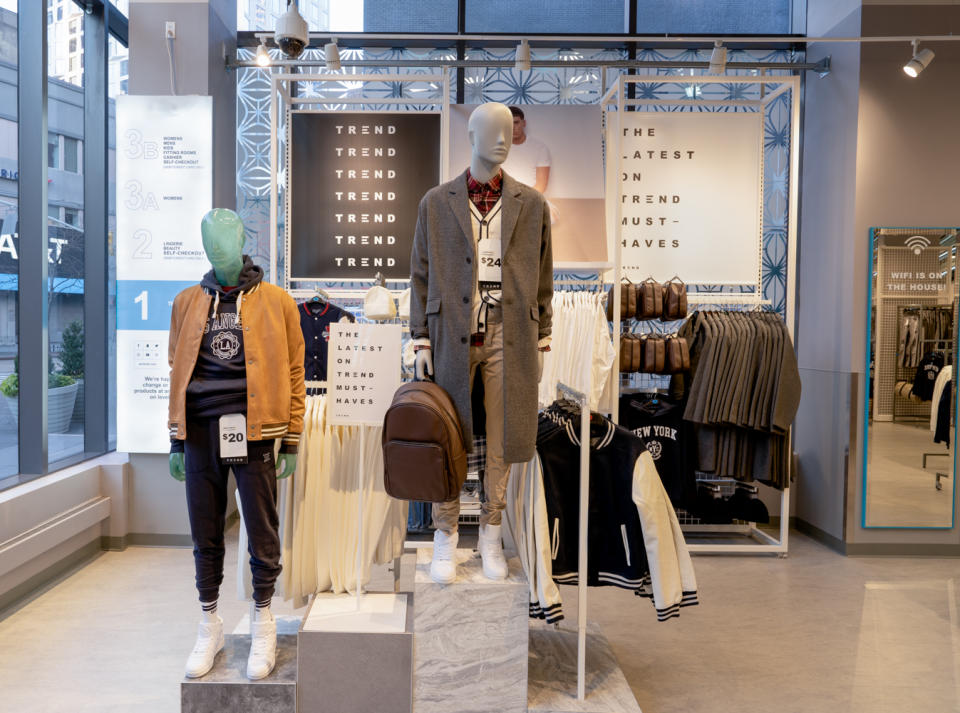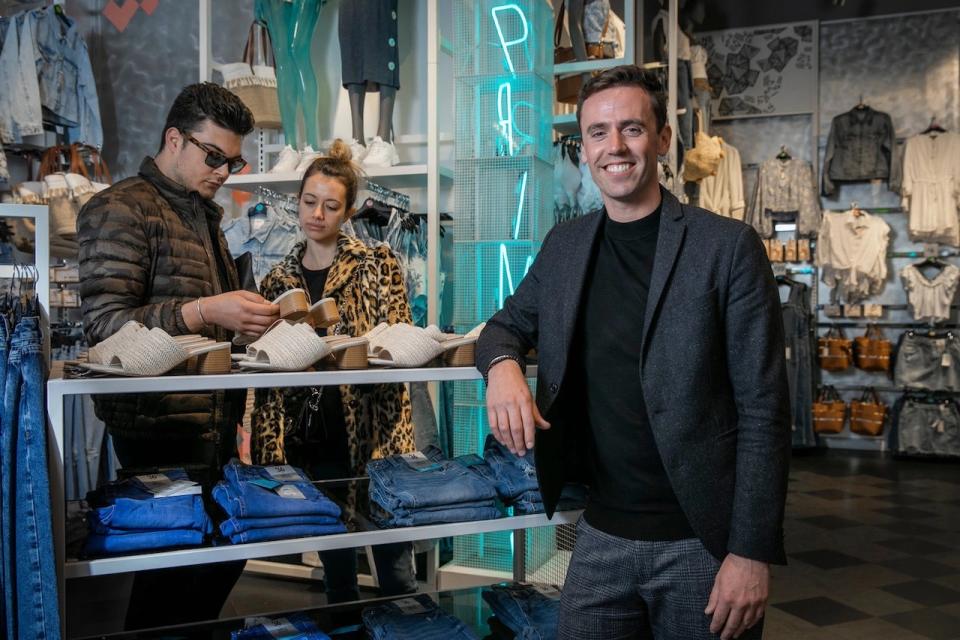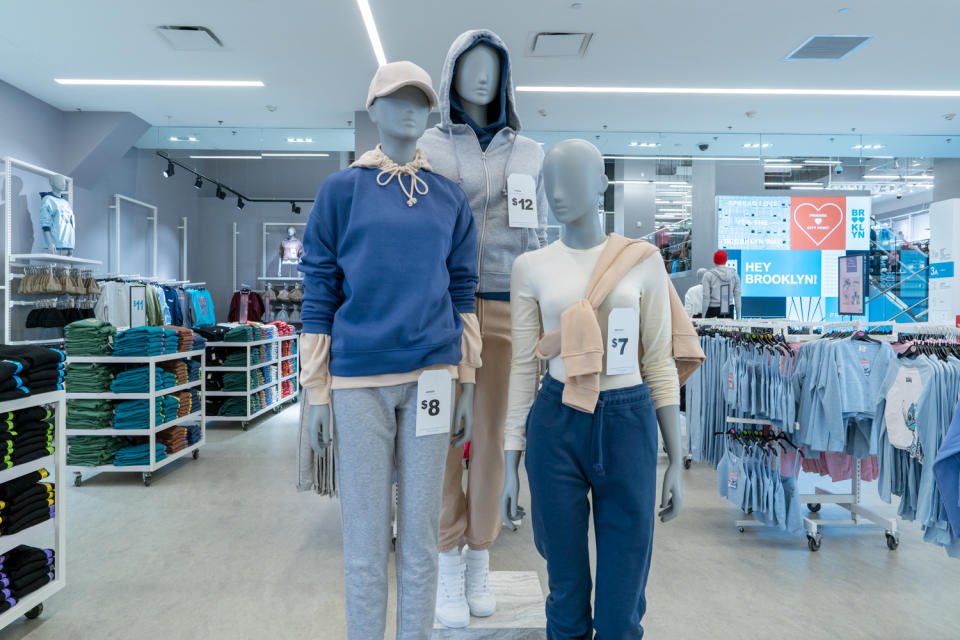Primark Brings Its Bargains to Downtown Brooklyn

NEW YORK — Primark is bringing its sharp-value, high-volume fashion format to downtown Brooklyn on Tuesday, with the opening of a three-level unit inside the City Point mixed-used development.
With 49,000 square feet of selling space, the store is filled with $3.50 T-shirt bras, $11 workout leggings, $10 men’s button-down shirts, $11 hoodies, faux fur gilets for $32, and skinny, wide-leg and torn jeans in the $10 to $26 range.
More from WWD
With the $4 women’s cycling shorts, “We sell thousands of these each week in the U.S.,” said Kevin Tulip, the president of Primark U.S., during a preview of the new store.
Further into the women’s active area, Tulip pointed to the $11 workout leggings. “There’s just incredible value on these,” he said. With Primark’s low prices, the margins may be tight, but Tulip assured that the retailer makes it up by selling the items in huge quantities.
At the Dublin-based Primark, which is owned by Associated British Foods, it’s hard to find anything over $50, except maybe hard-shell ridged rolling suitcases for $65, or some $55 outerwear. It’s all under the Primark label, with the exception of exclusive licensed merchandise from Disney, the NBA and others, that Primark manufactures and sells but designs in collaboration.
There’s never any of the high-low pricing, couponing, or “blockbuster” one-day sales other retailers regularly trumpet. “We will do markdowns when required. However, we don’t do big end-of-season sales,” Tulip explained. “We will do a small amount of clearance. But we look at that on a weekly basis. It’s not that we’re waiting until the end of the season, and then make a decision. Our founder [the late Arthur Ryan] was very clear around offering the right price, which is the first price.”

Primark’s newest store, housed in a former Century 21 off-price unit, does have some innovations, most obviously the 5,000-square-foot “trend” department on the street level. It’s for highlighting product launches and staging special events, and features Primark’s fashionable side, like its varsity jackets, priced $37; wide-leg jeans, priced $22, or plaid shackets, priced $35, paired with faux leather pants, $18, and high-top sneakers, $18. Primark’s basics and essentials are on floors two and three. The store is also testing self-checkout.
While Primark is heavily merchandised, it’s still a spacious environment in City Point, which is along Fulton Street, Brooklyn’s busiest retail corridor. Many of the display racks and tables are on wheels for easy, flexible merchandising to play up or play down products and categories depending on sales trends. Given the track and spot lighting and exposed ceilings there’s an overall contemporary, industrial feel.
Downtown Brooklyn is Primark’s 16th store in the U.S., and a high-profile step ahead in the company’s plan to have 60 stores operating in the U.S. by 2026. By then, Primark expects to have a total of 530 stores operating in Europe and the U.S., from the current 416. Primark entered the States in 2015 by opening in downtown Boston. Next year, openings are planned for Albany and Buffalo, New York.
It’s been a cautious, gradual expansion in the U.S., where Primark most directly competes with Old Navy, The Children’s Place, Penney’s, Kohl’s, and mainstream off-pricers. The majority of Americans remain unfamiliar with the retailer, though that changes as stores open. Primark does little traditional advertising, though is active on Instagram and other social media.
For most Americans, “It’s still a learning curve, but we’ve got two markets where I think our customer has gotten to know us — in Massachusetts, where we opened our first store in Boston, and then we continued with Braintree and Burlington soon after,” said Tulip. “And then we’ve got our Danbury, Connecticut, store, where we’ve continued to see great year-over-year increases. That’s telling me that our customer is not only coming back to shop with us more frequently but actually we’re starting to see bigger numbers of customers coming in as well.
“We don’t do traditional TV advertising. What we do is very much around social media, and we get out and talk about the brand. We do rely on word-of-mouth. We’ve had that for a long time in Europe. Opening a new store is always interesting to see how many people already are aware of our brand.”
Tulip, a 20-year veteran of Primark who started as a cashier at the store when he was 16, said he just spent a few days in Brooklyn, chatting with people in stores and restaurants. “People know Primark here. A lot of them have either already shopped with us in our stores in Kings Plaza, Brooklyn, or Staten Island, or they know us from Europe. Now when we open in say, Buffalo, we’re already preparing to do some early mall advertising and more around targeted social media because we know we won’t have the same brand affinity up in Buffalo yet. That will take a little bit more time.”

Since entering the U.S., one lesson Primark learned was that bigger isn’t always better. Some stores have been downsized. In Europe, the footprint is generally larger. The vast majority of the stores are on high streets as opposed to malls, which aren’t as commonplace there as they are in America.
“Malls are where we do most of our business in the U.S. and we’ll continue to,” said Tulip. “So actually it’s been about getting the right size of store in a mall, working with the right partner, of course, to make sure that the location has the footfall and the competitors we’re looking for. Thirty-five thousand square feet has really been the sweet spot for us in the U.S., though at the Roosevelt Field mall, Primark is actually 44,000 square feet, and here we have 49,000 square feet; 2.6 million people live in this borough. So we’re not afraid to take more space where we know that we’ve got a great location, and great footfall.”
Another key learning is that Primark licensed product is more in demand in the U.S. than in Europe. “We’ve continued to grow that offer to make sure that the U.S. stores have a bigger share of the buy in that,” said Tulip.
Being omnichannel capable isn’t something Primark has learned. The company doesn’t operate e-commerce, though Tulip disclosed it is testing buy online, pick up in store in 25 units in the U.K., though no home delivery is offered.
“There is opportunity in the U.S. for that middle-income customer to get to know Primark and to buy with us and to really start actually coming to Primark more often,” said Tulip. “We have the ability, with the cost-of-living crisis now, to offer that fantastic value to customers as well. We’re already very well placed with the product and price through our business model.”
He sees some advantage as a single channel retailer, operating stores only. “I have to say COVID[-19] just reminded us all of what we actually love — touching the product and being with people in stores. People realized what they’ve missed while it wasn’t there,” due to pandemic lockdowns.
Though there is nothing particularly Irish about the merchandise, Tulip said, “The way we operate our model, our mentality, is Irish through and through. We used to have two buying offices originally, one in the U.K. and one in Ireland and we merged them together. We now have a global buying team in Ireland that’s buying for 15 different countries,” where Primark operates stores. He said the buying team interacts often with the retail team in the stores.
“We’ll spend a lot of time together talking about culture and what’s happening and what we want more of and less of. It’s a very, very dynamic relationship we have. And that’s also very Irish. I mean, we can be quite tough with each other about what we need to be better on. But it’s not something that’s really conveyed to the general public in the United States.
“But I can tell you after 20 years with this company, we are a very Irish business. And Dublin is our center. We have an office in Boston [where Tulip is based] and, you know, there’s an office in Paris and an office in Milan, but those are smaller regional offices. We are still very centrally run from Dublin.”


